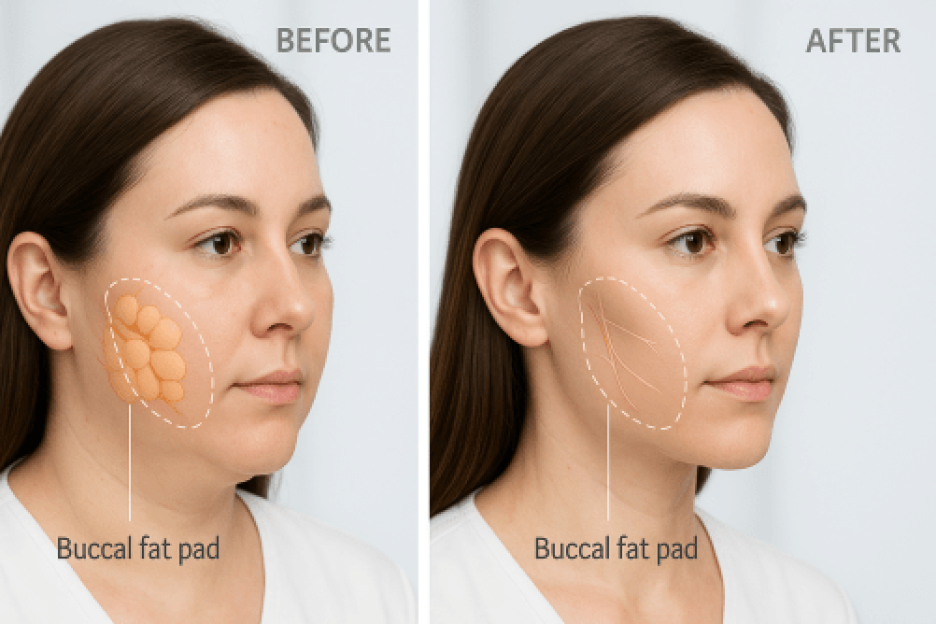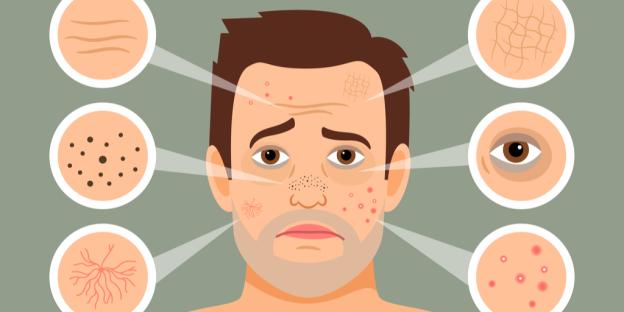The morning mirror reveals a face that’s always felt too round, too full in the cheeks, despite countless attempts at contouring makeup and facial exercises.
You trace your fingers along your cheekbones, imagining the sculpted, angular look you’ve admired on social media celebrities.
This feeling has led thousands of Americans to discover buccal fat extraction â a surgical procedure that promises to unlock the defined facial structure hidden beneath naturally fuller cheeks.
What Is Buccal Fat Extraction?
Buccal fat extraction, also known as buccal fat removal or cheek reduction surgery, is a cosmetic surgical procedure that removes fatty tissue from the lower portion of the cheeks. This fatty tissue, called the buccal fat pad, sits between the cheekbone and jawbone, contributing to facial fullness and roundness.
The procedure involves making small incisions inside the mouth to access and carefully remove portions of these fat pads. By reducing the volume of buccal fat, surgeons can create more defined cheekbones and a more sculpted facial appearance.
Understanding Buccal Fat Pads
Every person has buccal fat pads â they’re a natural part of facial anatomy. These fat deposits serve several purposes:
- Facial protection: They cushion the cheek muscles during chewing
- Facial volume: They contribute to youthful facial fullness
- Structural support: They help maintain facial contours
However, some people naturally have larger buccal fat pads, which can create a rounder, fuller facial appearance that may persist even with weight loss or aging.
The Growing Popularity of Buccal Fat Removal
Buccal fat extraction has gained significant popularity in recent years, particularly among millennials and Gen Z individuals seeking more defined facial features. Social media influencers and celebrities have openly discussed their experiences with the procedure, contributing to increased public awareness and demand.
According to the American Society of Plastic Surgeons, facial contouring procedures have increased substantially over the past decade. While specific statistics for buccal fat removal aren’t always separately tracked, cosmetic surgeons report a notable uptick in consultations for this procedure.
Celebrity Influence and Social Media Impact
The rise of facial contouring trends on platforms like Instagram and TikTok has played a significant role in popularizing buccal fat extraction. The procedure appeals to those seeking:
- Enhanced cheekbone definition
- More angular facial features
- Improved facial symmetry
- A mature, sophisticated appearance
Who Is a Good Candidate for Buccal Fat Extraction?
Not everyone is an ideal candidate for buccal fat removal. The best candidates typically share certain characteristics and have realistic expectations about the procedure’s outcomes.
Ideal Candidate Profile
Physical Characteristics:
- Naturally fuller cheeks due to prominent buccal fat pads
- Good overall facial bone structure
- Adequate skin elasticity
- Stable weight
- Age typically between 20-40 years
Psychological Readiness:
- Realistic expectations about results
- Understanding of permanent nature of the procedure
- Commitment to proper recovery
- No underlying body dysmorphia issues
Who Should Avoid Buccal Fat Extraction?
Certain individuals should carefully reconsider or avoid this procedure:
Age-Related Considerations:
- Very young patients (under 20) whose facial features are still developing
- Older patients (over 50) who may experience age-related facial volume loss
Physical Factors:
- Individuals with naturally thin faces
- Those with minimal buccal fat to begin with
- Patients with poor skin elasticity
- People with unrealistic expectations
Health Considerations:
- Active smoking habits
- Certain medical conditions affecting healing
- History of facial surgery complications
- Current pregnancy or breastfeeding
The Buccal Fat Extraction Procedure: Step by Step
Understanding the surgical process can help potential patients prepare mentally and physically for the procedure. Buccal fat extraction is typically performed as an outpatient procedure under local anesthesia with sedation or general anesthesia.
Pre-Operative Consultation
Before any surgery, patients undergo comprehensive consultations that include:
Medical History Review:
- Previous surgeries and medical conditions
- Current medications and supplements
- Allergies and adverse reactions
- Lifestyle factors affecting healing
Facial Analysis:
- Detailed examination of facial structure
- Photography from multiple angles
- Computer imaging to preview potential results
- Discussion of realistic expectations
Surgical Planning:
- Customized approach based on individual anatomy
- Amount of fat to be removed
- Potential risks and complications
- Recovery timeline and expectations
The Surgical Process
Preparation Phase:
- Administration of anesthesia (local with sedation or general)
- Surgical site cleaning and sterilization
- Marking of incision sites inside the mouth
Surgical Steps:
- Incision Creation: Small incisions (approximately 1-2 cm) made inside the mouth along the inner cheek
- Fat Pad Access: Careful dissection through cheek muscle to reach buccal fat pad
- Fat Removal: Gentle extraction of predetermined amount of fatty tissue
- Tissue Examination: Removed fat examined to ensure appropriate amount
- Closure: Incisions closed with dissolvable sutures
Post-Operative Care:
- Application of cold compresses
- Administration of antibiotics to prevent infection
- Pain medication as needed
- Detailed recovery instructions
Duration and Anesthesia Options
Procedure Length: Typically 30-60 minutes Anesthesia Types:
- Local anesthesia with sedation (most common)
- General anesthesia (for anxious patients or combination procedures)
Recovery Process and Timeline
Recovery from buccal fat extraction involves several stages, each with specific expectations and care requirements. Understanding this timeline helps patients plan appropriately and recognize normal healing progression.
Immediate Post-Operative Period (Days 1-3)
Common Experiences:
- Moderate facial swelling and bruising
- Mild to moderate discomfort
- Difficulty eating solid foods
- Temporary numbness in cheek area
- Slight difficulty speaking clearly
Care Instructions:
- Apply cold compresses 15-20 minutes every hour while awake
- Take prescribed antibiotics to prevent infection
- Use pain medication as directed
- Maintain head elevation while sleeping
- Follow liquid/soft food diet
Early Recovery Phase (Days 4-7)
Expected Changes:
- Gradual reduction in swelling
- Decreased pain and discomfort
- Improved ability to speak normally
- Introduction of soft solid foods
- Return to light daily activities
Continued Care:
- Gentle oral hygiene with saltwater rinses
- Avoid strenuous activities
- Continue cold compress applications
- Follow up with surgeon as scheduled
- Monitor for signs of complications
Intermediate Recovery (Weeks 2-4)
Progress Indicators:
- Significant swelling reduction
- Nearly normal eating abilities
- Return to most daily activities
- Initial results becoming visible
- Sutures dissolving (if not already removed)
Activity Guidelines:
- Gradual return to exercise (with surgeon approval)
- Resume normal oral hygiene routine
- Continue avoiding very hard or chewy foods
- Protect face from accidental trauma
Long-Term Recovery (Months 1-6)
Final Results Development:
- Complete swelling resolution
- Final facial contours emerging
- Full sensation return
- Complete tissue healing
- Stable, permanent results
Factors Affecting Recovery
Individual Variables:
- Age and overall health
- Skin elasticity and healing capacity
- Adherence to post-operative instructions
- Lifestyle factors (smoking, alcohol, stress)
- Previous facial surgeries
Environmental Factors:
- Climate and seasonal considerations
- Work environment and stress levels
- Available support system
- Access to proper nutrition
Potential Risks and Complications
Like any surgical procedure, buccal fat extraction carries certain risks and potential complications. Understanding these helps patients make informed decisions and recognize when to seek medical attention.
Common Minor Complications
Temporary Side Effects:
- Facial asymmetry during healing
- Prolonged swelling or bruising
- Temporary facial numbness or tingling
- Difficulty with certain facial expressions
- Minor scarring at incision sites
Management Strategies:
- Patient education about normal healing
- Appropriate follow-up scheduling
- Early intervention for complications
- Reassurance and support during recovery
Serious Complications (Rare)
Surgical Risks:
- Infection requiring antibiotic treatment
- Nerve damage affecting facial movement
- Excessive bleeding or hematoma formation
- Adverse reactions to anesthesia
- Poor wound healing or dehiscence
Long-Term Concerns:
- Overcorrection leading to gaunt appearance
- Premature facial aging
- Persistent asymmetry
- Need for revision surgery
- Dissatisfaction with results
Risk Reduction Strategies
Pre-Operative Measures:
- Thorough medical screening
- Realistic expectation setting
- Comprehensive surgical planning
- Proper pre-operative preparation
- Smoking cessation when applicable
Surgical Precautions:
- Experienced surgeon selection
- Conservative fat removal approach
- Careful tissue handling
- Sterile surgical environment
- Appropriate anesthesia monitoring
Post-Operative Care:
- Strict adherence to recovery instructions
- Regular follow-up appointments
- Early recognition of complications
- Appropriate medical intervention when needed
Expected Results and Outcomes
Understanding realistic expectations for buccal fat extraction results is crucial for patient satisfaction. The procedure’s outcomes vary based on individual anatomy, surgical technique, and healing characteristics.
Immediate vs. Final Results
Initial Appearance (First Few Weeks):
- Significant swelling may mask results
- Face may appear asymmetrical temporarily
- Final contours not yet visible
- Patients should avoid judging results too early
Progressive Changes (Months 1-6):
- Gradual swelling reduction reveals true results
- Facial contours become more defined
- Symmetry improves as healing progresses
- Final outcome becomes apparent
Typical Outcome Expectations
Positive Changes:
- More defined cheekbones and facial angles
- Reduction in facial roundness
- Enhanced jawline definition
- More mature, sophisticated facial appearance
- Improved facial proportions
Realistic Limitations:
- Results depend on existing bone structure
- Cannot create cheekbones where none exist
- May not achieve dramatic transformation
- Individual healing affects final appearance
- Some asymmetry may persist
Factors Influencing Results
Anatomical Considerations:
- Original buccal fat pad size
- Underlying bone structure
- Skin elasticity and thickness
- Facial muscle development
- Overall facial proportions
Surgical Variables:
- Amount of fat removed
- Surgical technique used
- Surgeon’s experience and skill
- Post-operative care quality
- Individual healing response
Long-Term Considerations
Aging Effects:
- Natural facial volume loss over time
- Potential for premature facial aging
- Need for future volume restoration
- Importance of conservative approach
Lifestyle Impact:
- Weight fluctuations affecting results
- Sun exposure and skin care importance
- Overall health and aging process
- Maintenance of results over time
Cost Analysis: What to Expect
The financial investment in buccal fat extraction varies significantly across the United States, influenced by multiple factors including geographic location, surgeon expertise, and facility type.
Average Cost Breakdown
National Average Ranges:
- Surgeon’s fee: $2,000 â $5,000
- Anesthesia costs: $400 â $800
- Facility fees: $500 â $1,200
- Total average cost: $3,000 â $7,000
Regional Variations:
- Major metropolitan areas: $4,000 â $8,000
- Suburban locations: $3,000 â $6,000
- Rural areas: $2,500 â $5,000
Factors Affecting Cost
Surgeon-Related Factors:
- Board certification and specialization
- Years of experience
- Reputation and demand
- Geographic location
- Practice overhead costs
Procedure-Related Factors:
- Anesthesia type required
- Facility type (hospital vs. surgery center)
- Additional procedures performed simultaneously
- Complexity of individual case
- Revision surgery needs
Geographic Considerations:
- Cost of living in the area
- Local market competition
- State regulations and licensing requirements
- Availability of qualified surgeons
Insurance and Financing
Insurance Coverage:
- Typically not covered by insurance (cosmetic procedure)
- Rare exceptions for reconstructive cases
- Medical necessity requirements
- Pre-authorization challenges
Financing Options:
- Medical credit cards (CareCredit, Prosper Healthcare)
- Personal loans through banks or credit unions
- Surgeon payment plans
- Third-party financing companies
- Credit card payments with promotional rates
Additional Costs to Consider
Pre-Operative Expenses:
- Initial consultation fees ($100-$300)
- Medical clearance costs
- Pre-operative testing
- Prescription medications
Post-Operative Costs:
- Follow-up appointment fees
- Prescription pain medications
- Special dietary requirements
- Time off work (lost wages)
- Potential complication treatments
Choosing the Right Surgeon
Selecting a qualified, experienced surgeon is perhaps the most critical decision in the buccal fat extraction journey. The surgeon’s skill directly impacts both safety and aesthetic outcomes.
Essential Qualifications
Board Certification Requirements:
- American Board of Plastic Surgery certification
- American Board of Facial Plastic and Reconstructive Surgery
- American Board of Otolaryngology (for facial procedures)
- Current, active certification status
- No disciplinary actions or malpractice issues
Specialized Training:
- Residency in relevant surgical specialty
- Fellowship training in facial cosmetic surgery
- Continuing education in latest techniques
- Experience with buccal fat extraction specifically
- Regular attendance at professional conferences
Evaluating Experience and Expertise
Procedure-Specific Experience:
- Number of buccal fat extractions performed
- Years performing the procedure
- Complication rates and management
- Before and after photo portfolio
- Patient testimonials and reviews
General Surgical Competence:
- Overall surgical experience
- Hospital privileges and affiliations
- Peer recognition and awards
- Teaching positions or publications
- Professional organization memberships
The Consultation Process
Initial Consultation Elements:
- Comprehensive facial analysis
- Detailed medical history review
- Discussion of goals and expectations
- Explanation of risks and benefits
- Review of before/after photos
Red Flags to Avoid:
- Pressure for immediate decisions
- Unrealistic promises or guarantees
- Lack of board certification
- No before/after photos available
- Unwillingness to discuss risks
Questions to Ask:
- How many buccal fat extractions have you performed?
- What are your complication rates for this procedure?
- Can I see before/after photos of similar cases?
- What happens if I’m unsatisfied with results?
- How do you handle complications?
Facility and Safety Standards
Accredited Facilities:
- AAAASF (American Association for Accreditation of Ambulatory Surgery Facilities)
- AAAHC (Accreditation Association for Ambulatory Health Care)
- Hospital-based surgical suites
- State licensing and inspection compliance
Safety Protocols:
- Emergency procedures and equipment
- Anesthesia safety standards
- Infection control measures
- Patient monitoring capabilities
- Staff qualifications and training
Alternative Options to Consider
Before committing to buccal fat extraction, patients should consider alternative approaches to facial contouring that may achieve similar results with different risk profiles.
Non-Surgical Alternatives
Injectable Treatments:
- Dermal fillers for cheekbone enhancement
- Botox for facial slimming effects
- Kybella for targeted fat reduction
- Thread lifts for facial contouring
Energy-Based Treatments:
- CoolSculpting for facial fat reduction
- Radiofrequency treatments for skin tightening
- Ultrasound therapy for facial contouring
- Laser treatments for skin improvement
Advantages of Non-Surgical Options:
- Lower risk profiles
- Minimal downtime required
- Reversible or temporary effects
- Lower financial investment
- Gradual, natural-looking changes
Limitations:
- Temporary results requiring maintenance
- May not achieve dramatic changes
- Multiple sessions often required
- Ongoing costs over time
Surgical Alternatives
Facelift Procedures:
- Deep plane facelifts for comprehensive rejuvenation
- Mini facelifts for moderate improvement
- Thread lifts for subtle lifting
- Combination procedures for optimal results
Bone Contouring Procedures:
- Cheek implants for enhanced definition
- Jawline implants for improved contours
- Chin augmentation for facial balance
- Comprehensive facial feminization or masculinization
Fat Transfer Procedures:
- Strategic fat grafting for facial enhancement
- Structural fat grafting for volume replacement
- Combination with other procedures
- Natural, long-lasting results
Timing Considerations
Age-Appropriate Decisions:
- Waiting for facial maturity (early twenties)
- Considering long-term aging effects
- Evaluating current facial volume
- Planning for future cosmetic needs
Combination Approaches:
- Staging procedures over time
- Combining surgical and non-surgical treatments
- Creating comprehensive treatment plans
- Optimizing overall facial harmony
Frequently Asked Questions
General Procedure Questions
Q: How long do results from buccal fat extraction last? A: Results are considered permanent since the removed fat cells do not regenerate. However, natural aging processes, weight changes, and facial volume loss over time can affect the long-term appearance.
Q: Can buccal fat extraction be reversed? A: The procedure cannot be reversed since the removed fat tissue is permanently gone. However, facial volume can be restored through fat grafting or dermal fillers if desired.
Q: Will I look gaunt or aged after the procedure? A: When performed conservatively by an experienced surgeon on appropriate candidates, the procedure should not create a gaunt appearance. However, over-extraction or performing the procedure on patients with naturally thin faces can lead to premature aging.
Q: How much fat is typically removed? A: The amount varies by individual, but typically 1-3 milliliters of fat are removed from each cheek. Conservative removal is generally preferred to avoid overcorrection.
Recovery and Results Questions
Q: When can I return to work after surgery? A: Most patients can return to desk work within 3-5 days, though visible swelling may persist for 1-2 weeks. Jobs requiring physical activity may require longer recovery time.
Q: Will there be visible scars? A: No external scars result from this procedure since all incisions are made inside the mouth. Internal scars are typically minimal and not visible.
Q: Can I eat normally after surgery? A: Initially, a liquid or soft food diet is recommended for the first few days. Normal eating can usually resume within a week, though very hard or chewy foods should be avoided for several weeks.
Q: Will the procedure affect my ability to smile or make facial expressions? A: Temporary stiffness or altered sensations are normal initially, but permanent changes to facial expressions are rare when the procedure is performed correctly.
Cost and Insurance Questions
Q: Does insurance cover buccal fat extraction? A: Insurance rarely covers this procedure since it’s considered cosmetic. Coverage might be possible in rare cases where the procedure is deemed medically necessary for functional reasons.
Q: Are there financing options available? A: Many plastic surgery practices offer financing plans through medical credit companies like CareCredit, or work with patients to establish payment plans.
Q: What’s included in the quoted price? A: Prices typically include the surgeon’s fee, facility costs, and anesthesia. However, patients should confirm what’s included and ask about additional costs for consultations, follow-up visits, or potential complications.
Safety and Risk Questions
Q: What are the most common complications? A: The most common issues are temporary swelling, bruising, and numbness. Serious complications like nerve damage or infection are rare but possible.
Q: How do I know if I’m a good candidate? A: Good candidates typically have fuller cheeks due to prominent buccal fat pads, realistic expectations, good overall health, and adequate facial bone structure. A consultation with a qualified surgeon is essential for proper evaluation.
Q: Can the procedure be combined with other cosmetic surgeries? A: Yes, buccal fat extraction is often combined with procedures like rhinoplasty, chin augmentation, or other facial surgeries. However, this increases overall risk and recovery time.
Making Your Decision: Key Considerations
Deciding whether to proceed with buccal fat extraction requires careful consideration of multiple factors beyond just the desire for facial contouring.
Personal Readiness Assessment
Emotional Preparedness:
- Realistic expectations about outcomes
- Understanding of permanent nature
- Acceptance of potential risks
- Support system availability during recovery
- Financial preparedness for all costs
Physical Readiness:
- Good overall health status
- Stable weight for at least six months
- No active infections or health issues
- Adequate time for proper recovery
- Commitment to post-operative care
Timing Considerations
Life Factors:
- Work schedule and ability to take time off
- Social commitments and upcoming events
- Seasonal considerations (avoiding hot weather)
- Support availability during recovery
- Financial stability and payment capability
Age-Related Timing:
- Facial development completion (usually after age 20)
- Current facial volume and structure
- Long-term aging considerations
- Future cosmetic procedure planning
Decision-Making Framework
Step 1: Research and Education
- Thorough understanding of the procedure
- Realistic expectation development
- Risk and benefit analysis
- Alternative option consideration
Step 2: Professional Consultation
- Multiple surgeon consultations
- Detailed discussions about candidacy
- Review of before/after photos
- Cost and financing discussions
Step 3: Personal Reflection
- Honest assessment of motivations
- Discussion with trusted friends/family
- Consideration of life impact
- Final decision making
Step 4: Preparation and Planning
- Surgeon selection and scheduling
- Financial arrangements
- Recovery period planning
- Support system coordination
Conclusion
Buccal fat extraction represents a significant decision that can permanently alter facial appearance. While the procedure offers the potential for enhanced facial definition and improved confidence, it requires careful consideration of numerous factors including candidacy, risks, costs, and long-term implications.
The key to a successful outcome lies in:
- Choosing a qualified, experienced surgeon who specializes in facial procedures
- Having realistic expectations about what the procedure can and cannot achieve
- Being an appropriate candidate with adequate facial structure and volume
- Following proper pre and post-operative care to optimize healing and results
- Understanding the permanent nature of the changes and their long-term implications
For those considering this procedure, investing time in thorough research, multiple consultations, and careful self-reflection is essential. The decision should never be rushed, and patients should feel completely comfortable with their choice, their surgeon, and their understanding of all aspects of the procedure.
Remember that facial beauty is subjective, and what matters most is how you feel about yourself. While buccal fat extraction can enhance facial definition for appropriate candidates, it’s not a solution for deeper self-esteem issues or unrealistic beauty standards.
If you decide to move forward, ensure you’re working with a board-certified plastic surgeon who prioritizes your safety, has extensive experience with the procedure, and shares your vision for natural-looking, harmonious results. The investment in quality care and expertise is invaluable when it comes to procedures that permanently alter your appearance.
Take your time, ask questions, and make the decision that’s right for your unique situation, goals, and circumstances. Your face is precious â treat it with the care and consideration it deserves.






